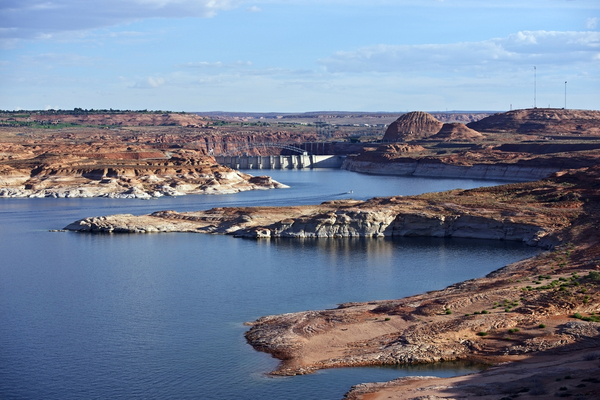Over 40 million people and a major agricultural sector rely on water from the Colorado River to sustain normal operations and a western American way of life. But after 23 years of over-use and dry conditions fueled by climate change, the river’s reservoir system is experiencing historic lows.
The reservoirs making up the Colorado River basin, Lake Powell and Lake Mead, supply water to 7 states. The Upper Basin states consist of Colorado, New Mexico, Utah, and Wyoming, while the Lower Basin includes California, Nevada, and Arizona. Ongoing extreme drought conditions coupled with unsustainable consumption have sapped the reservoirs’ available water supply. As of 2022, Lake Powell’s water level sat at a staggering 23% of full capacity, with Lake Mead coming in at just 27%.
Experts say that the term “drought” isn’t nearly sufficient to describe the changes occurring in the basin. What seems to be happening is a radical shift to a much drier climate – a process called aridification, which raises the concern that the reservoirs will never reach their pre-crisis capacity.
Over-allocation poses one of the greatest risks to long-term water security in the Colorado Basin. As demand vastly outpaces the supply, the water available in the system continues to dwindle, and environmental factors wreak havoc on the already-meager pools.
“Climate change is reducing the flow into the Colorado River system, so the agreements are divvying up more water than exists,” said Pierce, a scientist at Scripps Institution of Oceanography. “This drop in reservoir levels is happening because we are abiding by agreements that do not account for changes in water inflow into the system due to climate change.”
But Climate change isn’t the only thing endangering the Colorado River system. Evaporation and system losses contribute to an alarming 1.2 to 1.5 million acre-feet of water lost from the river each year – more than 10% of its total yield.
In light of the drought crisis, the basin states are being forced to meet federal pressure to reduce how much water they take from the over-burdened river. The Bureau of Reclamation, the government agency in charge of water management in the West, cites a need for urgent cutbacks on behalf of the states along the river. It put forth the Supplemental Environmental Impact Statement (SEIS) to restrict how much was released to water users in 2023 and 2024.
Despite the lack of consensus between the 7 states that make up the river basin, progress has been made toward more earnest initiatives to conserve water in major cities of the western U.S. In particular, Pheonix has allocated $295 million for a new pipeline to connect users to other water sources – and in Denver, efforts are being made to pay residents to remove non-functional turf, a wasteful water guzzler.
Las Vegas has put more aggressive usage restrictions into effect, as well as proposed to return immense quantities of treated wastewater to Lake Mead for reuse. Salt Lake City followed suit by cutting back consumption by 15% this past irrigation season, and Los Angeles is developing its own $3.4 billion water-recycling plant in tandem with Arizona and Nevada.
Now, due to the ongoing emergency in the Colorado Basin, further government expenditures for water conservation have recently been approved.
The Upper Colorado River states have been granted another $125 million to pay farmers and ranchers for temporary water rights, which allows them to keep enough water in Lake Powell and Lake Mead to operate the dams. Known as the System Conservation Pilot Program, this initiative is the second trial of an earlier pilot that ran from 2015 to 2018 and saved up to 50,000 acre-feet of water.
What these measures go to show is that the water crisis is beginning to receive the spotlight it deserves – a notable step forward in the fight to preserve the Colorado River’s title as the “American Nile” and lifeblood of the Basin. “Well-directed funding today will help farmers, ranchers, cities, and the environment prospers in a more arid future,” said Bart Miller, Western Resource Advocates Healthy Rivers Director. “This is a key down payment, but additional resources will be needed in future years, as the challenge is large.”
Make no mistake: the situation in the Colorado Basin is dire, but there is a determination to adapt to the rapidly changing western landscape. While the future of the river and its reservoirs are uncertain, what can be expected is further federal spending to assist states in sticking to their water budget as awareness is raised about the issue at hand.
“I’m extremely hopeful,” said Lis Mullin Bernhardt, a freshwater expert with the United Nations Environment Programme, in an interview. “I see change happening. I see a positive future that might look a bit different from how we’re living now, but it’s still a very worthwhile future. I’ve got no doubt we’ll find solutions.”
—
Photo Credit: Virrage Images / Shutterstock.com
